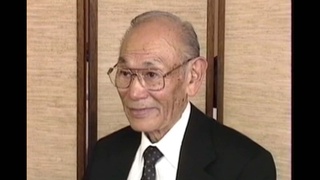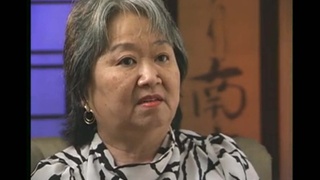Interviews
442 soldiers visiting U.S. concentration camps
Dan Inouye tells the story of how he was in the 442nd at Camp Shelby. The conflict between the Japanese from Hawaii, called Buddhaheads, and the Japanese from the mainland, called Kotonks getting in constant fights, and he says that it became so bad, they were thinking of disbanding the 442nd. And someone, they did counseling and all of this but nothing seemed to work.
So they, someone had the bright idea that maybe these Hawaii boys ought to see what the Japanese on the mainland experienced. So Dan says, some of the Hawaii boys, the leaders of the Hawaii gangs were put on buses and sent to, I guess, Jerome or Rohwer in Arkansas to see the camps. And they were just amazed at what they saw. So the attitudes changed towards the Kotonks. And as Dan says, "Would we have volunteered had we been treated that way? Put in concentration camps."
So... but, I don't think you really, Mitch, you can't get the full flavor of this. So in a sense, I'm hoping that if I get to Rohwer or Jerome I'd get a -- of course, my uncle was interned. And I think he was at Jerome for a while, his whole family, and at Tule Lake. And one of the ironies was when I was in the army and I was gonna be shipped overseas, the war, and from -- fortunately, the war with Japan had just ended. I stopped by -- as I was sent to Fort Mason in San Francisco -- I stopped by to see my uncle in Tule Lake.
And here I am in a uniform of the U.S. army, and I've got to get checked through to see my uncle who's interned in Tule Lake. There's an irony in this.
Date: March 19, 2004
Location: California, US
Interviewer: Mitchell Maki
Contributed by: Watase Media Arts Center, Japanese American National Museum.
Explore More Videos

Choice to move east or go to Japan
(b.1920) Japanese Canadian Nisei. Established the Ikenobo Ikebana Society of Toronto


Institutionalization as a bad aspect of camp
(1924-2018) Researcher, Activist

State Department records show concern for treatment of Japanese American internees
(1924-2018) Researcher, Activist

Remembering December 7, 1941
(1923-2011) Lawyer, MIS veteran, founder of Francis and Sarah Sogi Foundation

Meeting Japanese Americans from the mainland in MIS
(1923-2011) Lawyer, MIS veteran, founder of Francis and Sarah Sogi Foundation

Awareness of concentration camps as a Japanese American
(1923-2011) Lawyer, MIS veteran, founder of Francis and Sarah Sogi Foundation

Manhunt
(1919 - 2005) Challenged the constitutionality of Executive Order 9066.

The Final Verdict
(1919 - 2005) Challenged the constitutionality of Executive Order 9066.


Reaction to a 1942 speech by Mike Masaoka, Japanese American Citizen League's National Secretary
(1915 - 2011) Nisei florist who resettled in New York City after WW II. Active in Japanese American civil rights movement


Reasons for conformity and competitiveness in Gardena, California
(b. 1946) Lawyer

Role of the redress movement in helping Nisei to open up about their wartime experiences
(b. 1946) Lawyer

Search of family home by the FBI following the bombing of Pearl Harbor
(1937 - 2021) Teacher
